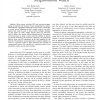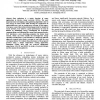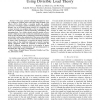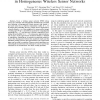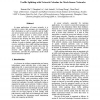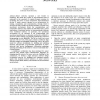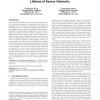110
Voted
ICC
2007
IEEE
15 years 6 months ago
2007
IEEE
—Recent Advances in Distributed Source Coding (DSC) for mission-driven Wireless Sensor Networks (WSN) are related to the coding for multiple correlated sensors in applications su...
101
click to vote
ICC
2007
IEEE
15 years 6 months ago
2007
IEEE
Abstract— Many sensor networks (SN) use in-network aggregation to minimize the amount of data transmitted by sensors. Unfortunately, aggregation makes the network more vulnerable...
125
click to vote
ICC
2007
IEEE
15 years 6 months ago
2007
IEEE
—Data gathering is a major function of many applications in wireless sensor networks (WSNs). The most important issue in designing a data gathering algorithm is how to save energ...
117
Voted
GLOBECOM
2007
IEEE
15 years 6 months ago
2007
IEEE
Abstract— This paper presents scheduling strategies for sensing workload in wireless sensor networks using Divisible Load Theory (DLT), which offers a tractable model and realist...
GLOBECOM
2007
IEEE
15 years 6 months ago
2007
IEEE
— In this paper we use an information flow model for placement of traffic sinks in a wireless sensor network. Our mathematical model translates a communication network composed...
93
Voted
GLOBECOM
2007
IEEE
15 years 6 months ago
2007
IEEE
— Given a wireless sensor network (WSN) whose sensors are randomly and independently distributed in a bounded area following a homogeneous Poisson process with density ρ and eac...
111
click to vote
FGCN
2007
IEEE
15 years 6 months ago
2007
IEEE
In many applications of sensor networks, it is essential to ensure that messages are transmitted to their destinations as early as possible and the buffer size of each sensor node...
111
click to vote
COMSWARE
2007
IEEE
15 years 6 months ago
2007
IEEE
—Sensor networks represent a new frontier in technology that holds the promise of unprecedented levels of autonomy in the execution of complex dynamic missions by harnessing the ...
108
click to vote
CODES
2007
IEEE
15 years 6 months ago
2007
IEEE
As an emerging technology, sensor networks provide the ability to accurately monitor the characteristics of wide geographical areas over long periods of time. The lifetime of indi...
107
click to vote
CISS
2007
IEEE
15 years 6 months ago
2007
IEEE
— We consider a sensor network in which the sensors communicate at will when they have something to report, without prior coordination with other sensors or with data collection ...

